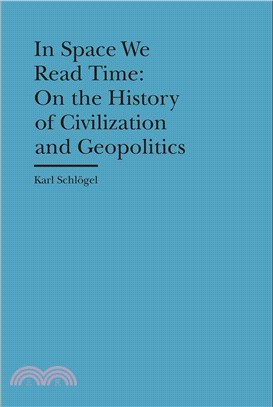In Space We Read Time ― On the History of Civilization and Geopolitics
商品資訊
ISBN13:9781941792087
出版社:Bard Graduate Center
作者:Karl Schl?搪l; Gerrit Jackson (TRN)
出版日:2016/11/15
裝訂/頁數:精裝/550頁
規格:22.9cm*15.2cm (高/寬)
定價
:NT$ 2250 元無庫存,下單後進貨(到貨天數約30-45天)
下單可得紅利積點:67 點
商品簡介
作者簡介
相關商品
商品簡介
Karl Schlogel’s In Space We Read Time is a unique book, both path breaking and stocktaking at the same time. Following the “spatial turn” in historiography in the 1980s and 90s but also following his own extraordinary city-writing in the Soviet bloc of those same decades (later published as Moscow 1937 by Polity Press in 2012, and designated by The Atlantic as one of the five best books of the year and winner of the Leipzig Book Prize for European Understanding), this book is both a model for thinking about the history in space, and a stimulating history of thinking about space in (mostly) Germany and the East in the twentieth century; the book also contains wonderful little essays on the United States and Los Angeles. Schlogel’s discussions range from intellectual history of the highest order (discussing the history of geography in Germany and France at the end of the nineteenth century), to hidden narratives of the spatial (hand-drawn maps made in and of the Kovno ghetto by inmates) to microhistories (study of the Berlin phone book of the early 1930s). And always there is Schlogel’s keen eye for the important detail and his ability to build out from the microanalysis to the world-historical. Bringing his background as both a historian of Russia and a frequent contributor to the German feuilleton sections, Schlogel sees space the way a historian sees a source and a writer sees a story. The combination is thrilling. Because of its erudite base, this book could as easily function as an introduction to spatial studies as it could a highly specialized examination of the way space has played a role in eastern European history in the twentieth century. There is no one else who brings together these skills and viewpoints along with the style to grip readers.
?
Or you can use/adapt Hanser’s description:
?
Finding your Bearings
?
The narratives of traditional historiography have too often neglected space and place. Karl Schlogel’s fascinating new book engages with the ‘spatial turn’, reading historical periods and sequences of events within the context of their geographical location. Taking as his inspiration Walter Benjamin’s flaneur, who investigates the history of a city by strolling through it, Schlogel explores the topography of history. In his quest for a type of history that takes full account of space, he reads landscapes, towns, maps, directories and railway timetables. Do you know the origin of the name ‘Everest’? Have you thought about what the layout of American towns can tell you about the American Dream? This book reveals this and much, much more.
?
The book is packed, moreover, with fascinating insights drawn from unusual sources. Examining a town directory from early 1930s Berlin, Schlogel brings to light a whole variety of trades that have since disappeared, allowing the reader a glimpse of a bygone era. Poring over a railway timetable from pre-1914 Austria-Hungary, he shows how vast expanses of territory could be covered relatively simply – the journeys were not hindered by border controls. Schlogel hones in on the idea of ‘map reading’ and deals with the significance of maps of all kinds. Of course, maps always contain a subjective dimension, often traditionally emphasising the importance of the home territory. They can also be used to serve a whole variety of purposes, one poignant example of this being the atlas of emigration produced by the German Jewish community in 1938, which showed the few remaining possibilities for escape. Another example of a map with a specific purpose, albeit of a very different kind, is Henry Beck’s map of the London Underground. Here, the sole purpose was to facilitate the journey, while other ‘normal’ features of maps, for example scale, were ignored.
?
The overall importance of maps and mapping history is underlined by reference to Jefferson’s map of the United States, the British survey of India, and the presence of so many cartographers in the entourage of President Wilson at the Versailles Treaty of 1919, where the aim was to redraw Europe’s boundaries on the basis of ethnicity.
?
Moving easily from the voyages of discovery to 9/11 and from Vermeer’s paintings to the fall of the Berlin wall, this intriguing book presents history from a new perspective.
?
?
?
Or you can use/adapt Hanser’s description:
?
Finding your Bearings
?
The narratives of traditional historiography have too often neglected space and place. Karl Schlogel’s fascinating new book engages with the ‘spatial turn’, reading historical periods and sequences of events within the context of their geographical location. Taking as his inspiration Walter Benjamin’s flaneur, who investigates the history of a city by strolling through it, Schlogel explores the topography of history. In his quest for a type of history that takes full account of space, he reads landscapes, towns, maps, directories and railway timetables. Do you know the origin of the name ‘Everest’? Have you thought about what the layout of American towns can tell you about the American Dream? This book reveals this and much, much more.
?
The book is packed, moreover, with fascinating insights drawn from unusual sources. Examining a town directory from early 1930s Berlin, Schlogel brings to light a whole variety of trades that have since disappeared, allowing the reader a glimpse of a bygone era. Poring over a railway timetable from pre-1914 Austria-Hungary, he shows how vast expanses of territory could be covered relatively simply – the journeys were not hindered by border controls. Schlogel hones in on the idea of ‘map reading’ and deals with the significance of maps of all kinds. Of course, maps always contain a subjective dimension, often traditionally emphasising the importance of the home territory. They can also be used to serve a whole variety of purposes, one poignant example of this being the atlas of emigration produced by the German Jewish community in 1938, which showed the few remaining possibilities for escape. Another example of a map with a specific purpose, albeit of a very different kind, is Henry Beck’s map of the London Underground. Here, the sole purpose was to facilitate the journey, while other ‘normal’ features of maps, for example scale, were ignored.
?
The overall importance of maps and mapping history is underlined by reference to Jefferson’s map of the United States, the British survey of India, and the presence of so many cartographers in the entourage of President Wilson at the Versailles Treaty of 1919, where the aim was to redraw Europe’s boundaries on the basis of ethnicity.
?
Moving easily from the voyages of discovery to 9/11 and from Vermeer’s paintings to the fall of the Berlin wall, this intriguing book presents history from a new perspective.
?
?
作者簡介
Karl Schlogel is professor emeritus of Eastern European history at the European University Viadrina in Frankfurt an der Oder.Gerrit Jackson is a translator based in Berlin.
主題書展
更多
主題書展
更多書展今日66折
您曾經瀏覽過的商品
購物須知
外文書商品之書封,為出版社提供之樣本。實際出貨商品,以出版社所提供之現有版本為主。部份書籍,因出版社供應狀況特殊,匯率將依實際狀況做調整。
無庫存之商品,在您完成訂單程序之後,將以空運的方式為你下單調貨。為了縮短等待的時間,建議您將外文書與其他商品分開下單,以獲得最快的取貨速度,平均調貨時間為1~2個月。
為了保護您的權益,「三民網路書店」提供會員七日商品鑑賞期(收到商品為起始日)。
若要辦理退貨,請在商品鑑賞期內寄回,且商品必須是全新狀態與完整包裝(商品、附件、發票、隨貨贈品等)否則恕不接受退貨。
























